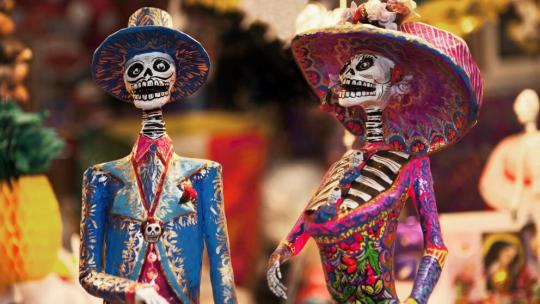Dia De Los Muertos

What is Día de los Muertos?
Día de los Muertos (The Day of the Dead) is a Mexican holiday that honors and welcomes back the souls of deceased loved ones for a brief reunion filled with food, drink, and celebration. Blending Mesoamerican ritual, European religion, and Spanish culture, the holiday is celebrated each year from October 31 through November 2.
While October 31 is known as Halloween, November 1 is Día de los Angelitos (Day of the Little Angels) and November 2 is All Souls’ Day, or the traditional Day of the Dead. According to tradition, the gates of heaven open at midnight on October 31, allowing the spirits of children to reunite with their families for 24 hours. The spirits of adults return the following day to join in the celebration.
Origins of the Day of the Dead
The roots of Día de los Muertos stretch back more than 3,000 years, to the pre-Columbian civilizations of Mesoamerica, where rituals honoring the dead were an essential part of life. The Aztecs and other Nahua peoples in what is now central Mexico viewed death as an integral, cyclical part of existence.
According to Aztec belief, when a person died, their soul embarked on a journey through Chicunamictlán (the Land of the Dead). Only after passing through nine challenging levels could the soul reach Mictlán, its final resting place. To assist the deceased on this journey, families would offer food, water, and tools, a tradition that inspired today’s ofrendas (home altars) and graveside offerings of food, flowers, and personal items.
How is Día de los Muertos Celebrated?
Although often associated with Halloween, Día de los Muertos is not a Mexican version of Halloween. While both involve costumes and festive imagery, Día de los Muertos is a joyful celebration of life and remembrance rather than fear or fright.
It is believed that during these days, the boundary between the living and spirit worlds dissolves, allowing the souls of the dead to return and celebrate with their loved ones. Families welcome these visits with music, food, laughter, and prayer, treating their ancestors as honored guests.
Ofrendas (altars) are central to the celebration and are adorned with candles, bright marigolds (cempasúchil), photographs, sugar skulls, and favorite foods or belongings of the departed.
November 1 – Día de los Angelitos (Day of the Little Angels): Families honor the souls of deceased children with altars decorated with their favorite snacks, candies, toys, and photos. The names of the children are often written on sugar skulls (calaveras).
November 2 – Día de los Muertos (Day of the Dead): The focus shifts to departed adults. Ofrendas feature pan de muerto (bread of the dead), mezcal, tequila, atole, and other traditional items. Families gather to share stories, play games, and dance to music that fills their towns and homes.
In many communities, Día de los Muertos culminates in public celebrations and parades. Participants paint their faces as calaveras (skeletons) and fill the streets with color, music, and movement. Families also visit cemeteries to clean and decorate graves with flowers, candles, gifts, and sugar skulls, creating vibrant, sacred spaces that honor both memory and life.

